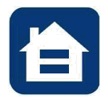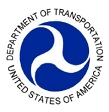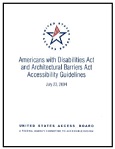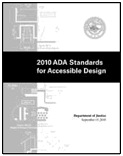Using the ADA Standards

The design standards issued under the Americans with Disabilities Act (ADA) by the Department of Justice and the Department of Transportation are used to ensure access to the built environment for people with disabilities. The ADA Standards apply nationwide, in addition to any applicable state or local codes, where facilities are newly built or altered. Most facilities in the public and private sectors are covered by the ADA.
State and Local Government Facilities

Units of government at the state, county, and local levels are subject to the ADA and must comply with the ADA Standards in new construction and alterations. All types of public facilities are covered, including schools, hospitals, public housing, courthouses, and prisons. Federal facilities are not covered by the ADA, but by an earlier law, the Architectural Barriers Act (ABA) and must meet separate, though very similar, standards.
Places of Public Accommodation and Commercial Facilities

In the private sector, the ADA Standards apply to places of public accommodation and commercial facilities. Places of public accommodation are facilities that affect commerce and that fall within twelve categories listed in the statute, including stores and shops, restaurants and bars, sales or rental establishments, service establishments, theaters, places of lodging, recreation facilities, assembly areas, private museums, places of education, and others. Nearly all types of private businesses that serve the public are included in the twelve categories, regardless of size. Commercial facilities include office buildings, factories, warehouses, manufacturing plants, and other facilities whose operations affect commerce.
Transportation Facilities

Bus stops and stations, rail stations, and other transportation facilities are required to be accessible by the ADA. The ADA also establishes standards for transportation vehicles, including buses, vans, and rail cars (which are not discussed in this guide).
Exemptions (Religious Entities and Private Clubs)
The ADA does not apply to religious organizations and private clubs, entities which historically have been exempt from federal civil rights laws. Places of worship and other facilities controlled by a religious organization, such as a school or day care center, are not subject to the ADA Standards. Private clubs may be similarly exempt depending on their exclusiveness, operations, and other factors. Facilities not subject to the ADA Standards may still be subject to state or local access codes.
ADA Coverage of Housing
Although private residential housing is not covered by the ADA, government-owned or operated housing and certain privately owned facilities that provide housing are subject to the ADA and its accessibility requirements. Government owned or operated facilities may include public housing, student and faculty housing, employee housing, nursing homes, temporary housing provided in emergencies, and social service facilities, such as homeless shelters and halfway houses.

In the private sector, the ADA’s coverage of housing is limited to places of public accommodation, such as social service establishments and housing provided on or behalf a place of education. The ADA does not apply to individually owned or leased housing in the private sector not used as a public accommodation, including single family homes, condominiums, or apartments. (Many types of multi-family housing in the private and public sectors are subject to the design requirements of the Fair Housing Act.) Places of public accommodation located in residential buildings, such as rental and sales offices, commercial spaces, and hotel accommodations, are covered by the ADA Standards. Information on the Fair Housing Act is available from the Department of Housing and Urban Development at http://www.hud.gov/ or http://www.fairhousingfirst.org/,(888) 341-7781 (V/TTY).
ADA Regulations
Regulations issued by DOJ and DOT to implement the ADA provide important information and instructions on using the ADA Standards. The regulations define the types of facilities covered, set effective dates, and provide additional detail on certain provisions in the standards. They also address existing facilities and topics beyond building design, including access to programs, services, and communication and provision of auxiliary aids and services.
DOJ’s ADA Regulations

DOJ regulations issued under title II of the ADA apply to programs, activities, and services of state and local governments. DOJ’s title III regulations apply to public accommodations and commercial facilities. Both regulations contain general nondiscrimination provisions and address access to programs and services, effective communication, auxiliary aids and services, and reasonable modifications of policies, practices, and procedures. Under the title II regulation, state and local governments must provide program accessibility in existing facilities, and the under the title III regulation public accommodations must remove architectural barriers in existing facilities where it is “readily achievable.” In addition, both regulations specify the accessibility standards applicable to new construction and alterations, and to the provision of program access or barrier removal.

Title II Regulation for State and Local Governments
28 CFR Part 35
Available at http://www.ada.gov/

Title III Regulation for Places of Public Accommodation and Commercial Facilities
28 CFR Part 36
Available at http://www.ada.gov/
DOT’s ADA Regulations

DOT’s ADA regulations implement the transportation and related provisions of titles II and III of the ADA. They apply to any public entity that provides public transportation or intercity or commuter rail transportation, as well as to any private entity that provides public transportation or that is not primarily engaged in the business of transporting people but operates a demand responsive or fixed route system. They cover both vehicles and facilities and include nondiscrimination requirements associated with the provision of transportation services.

DOT Regulation for Transportation Services
49 CFR Part 37
Available at http://www.fta.dot.gov/civilrights/12325.html
ADA Accessibility Standards

DOJ’s and DOT’s ADA Standards are based on the Board’s ADA Accessibility Guidelines (2004).
Both DOJ’s and DOT’s ADA Standards are based on minimum accessibility guidelines adopted by the Access Board in 2004, known as the ADA Accessibility Guidelines. As a result, these two sets of standards are very similar for the most part. However, each contains additional requirements that are specific to the facilities covered by the respective agencies.
DOJ’s 2010 ADA Standards for Accessible Design
DOJ’s 2010 ADA Standards for Accessible Design became effective March 15, 2012 and apply to all facilities covered by the ADA except public transit facilities. This includes state and local government facilities subject to title II and places of public accommodation and commercial facilities under title III.
As implemented under title II, the 2010 Standards consist of the regulatory provisions in 28 CFR §35.151 and appropriate sections of the Access Board’s 2004 ADA Accessibility Guidelines (36 CFR part 1191, appendices B and D).
For title III of the ADA, the 2010 Standards consist of both the regulatory provisions in 28 CFR part 36, subpart D, and appropriate sections of the Access Board’s 2004 ADA Accessibility Guidelines (36 CFR part 1191, appendices B and D).
DOJ’s 2010 ADA Standards are available on DOJ’s ADA website at http://www.ada.gov/.
DOJ’s 2010 Standards include provisions not included in DOT’s standards that supplement or modify requirements related to scoping for:
-
assembly areas (§221)
-
medical care facilities (§223)
-
transient lodging, including housing at places of education (§224)
-
detention and correctional facilities (§232)
-
social service establishments (§233)
-
housing provided by state or local governments for sale to individual owners (§233).
DOT’s ADA Standards (2006)
DOT’s ADA Standards apply to facilities used by state and local governments to provide designated public transportation and to commuter and intercity rail stations. The current edition of the standards applies to new construction and alterations undertaken after November 29, 2006. These standards are very similar to DOJ’s 2010 Standards but include unique provisions concerning:
-
accessible route location (§206.3)
-
detectable warnings on curb ramps (§406.8)
-
bus boarding and alighting areas (§810.2.2)
-
rail station platform (§810.5.3).
How the ADA Standards are Enforced
DOJ’s and DOT’s ADA Standards are not a building code, nor are they enforced like one. They constitute design and construction requirements issued under a civil rights law. The ADA’s mandates, including the accessibility standards, are enforced through investigations of complaints filed with federal agencies, or through litigation brought by private individuals or the federal government. There is no plan review or permitting process under the ADA. Nor are building departments required or authorized by the ADA to enforce the ADA Standards (some building departments even include a disclaimer on their plan checks indicating that ADA compliance is not part of their approval process). Entities covered by the law ultimately are responsible for ensuring compliance with the ADA Standards in new construction and alterations.
State and Local Access Codes
Building design and construction, including safety and accessibility, is largely regulated and enforced by states and local jurisdictions. The ADA does not intrude upon the authority these governmental entities have traditionally exercised over the built environment. Most states and many local jurisdictions have laws or ordinances that address access to the built environment. Several states have their own accessibility codes, while others have implemented requirements based on those of the ADA or adopted access provisions contained in model building codes. The ADA Standards apply nationally in addition to any applicable state or local access requirements or codes. An occupancy permit issued by a local jurisdiction (or a building inspection) does not ensure ADA compliance. Although local building departments sometimes can waive building code requirements, a local waiver does not affect the entity’s obligation to comply with the ADA Standards.
State or Local Code Certification
The ADA sets up a voluntary process through which a state code can be certified by DOJ as meeting or exceeding the ADA Standards that apply to public accommodations and commercial facilities. Certification facilitates compliance by ensuring that state and local code requirements are consistent with the ADA accessible design requirements. This process, in effect, integrates the requirements for accessible design under the ADA into state or local code enforcement processes. Under a certified code, design errors are more likely to be caught and remedied before construction. Also, having a DOJ-certified code offers rebuttable evidence of compliance with title III of the ADA in response to a legal challenge under the law concerning accessible facility construction. Information on ADA state code certification is available from DOJ and its website at www.ada.gov/certcode.htm. DOT does not certify codes as compliant with its ADA Standards for transportation facilities.
Model Building Codes and Industry Standards
The Access Board’s 2004 ADA Accessibility Guidelines, upon which the current ADA Standards are based, have been harmonized to a significant extent with industry standards and model building codes, including the International Building Code (IBC). The IBC contains application and scoping provisions for accessibility (in chapters 10, 11 and 34) that correspond to those in the ADA guidelines (chapters 1 and 2). For technical provisions, the IBC references a consensus standard developed through the American National Standards Institute (the ANSI A117.1 standard), which is highly consistent with the technical chapters (3-10) of the ADA guidelines. There are some substantive differences. For example, unlike the ADA guidelines, the ANSI standards require an additional vertical grab bar at water closets, transfer shower stalls, and tubs. Detailed comparisons between the 2004 ADA guidelines and the IBC/ANSI standard are available on the Access Board’s website and the International Code Council’s website at www.iccsafe.org.
The ADA Standards also reference several industry standards, including the American Society of Mechanical Engineers (ASME) elevator safety code and the National Fire Protection Association (NFPA) 72 Fire Alarm Code. In addition, the ADA Standards reference provisions in the IBC covering accessible means of egress.




User Comments/Questions
Add Comment/Question